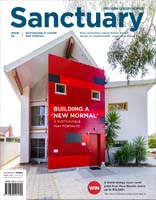Design workshop: A higher-performing volume build

Kirsten and James are keen to make the project home they’re planning in Camberwell, Victoria, as energy-efficient and comfortable as possible, and have budgeted for some upgrades. Architect Penny Guild and ESD consultant Erika Bartak give the couple some advice on achievable tweaks to improve their home’s performance.
The family loves the area they live in, but needs more growing space than their existing house can provide. Having reluctantly decided, after two years of talking to architects and builders, that renovating was impractical and a custom-designed home beyond their budget, Kirsten and James were considering selling and moving somewhere more affordable. “Then one day we popped into a display home estate for a bit of fun,” Kirsten says. “James saw a house he liked and we checked out the builder’s website. There was a design that was similar to what we wanted for under $400,000, so we thought we would investigate.”
Design 011 from local builder Hallbury Homes fits onto the family’s small, subdivided block; importantly for Kirsten, the open-plan kitchen, living and dining area is at the back of the house for good connection to the back garden. A main bedroom suite, laundry and garage are also downstairs, and upstairs has three more bedrooms, a study, rumpus room and bathroom.
James and Kirsten worked with Hallbury’s in-house designer to make some layout changes and upgrades, including reducing the size of the upper level, adding a verandah on the west and converting the covered ‘alfresco’ outdoor living to a patio with pergola for better northern solar access to the living room. They have beefed up the wall and ceiling insulation and budgeted for a water tank, solar PV and a greywater system. All windows are double-glazed (standard for Hallbury builds) except the sliding doors in the living area.
The couple are keen to reduce the need for lights, heating and cooling, and asked Erika and Penny for further advice on design features they can change to meet this goal, within the scope of the volume-built model. In particular, they are wondering about window sizes and placement for optimal solar gain and ventilation, and options for eaves and shading.
The Brief
- A 4-bedroom home with a study
- Good visual connection with and easy access to the garden
- Spaces for family connection and for quiet time
- Optimised window placement and eaves for passive solar performance
- Energy efficient: minimal reliance on active heating and cooling
- Solar PV and greywater recycling
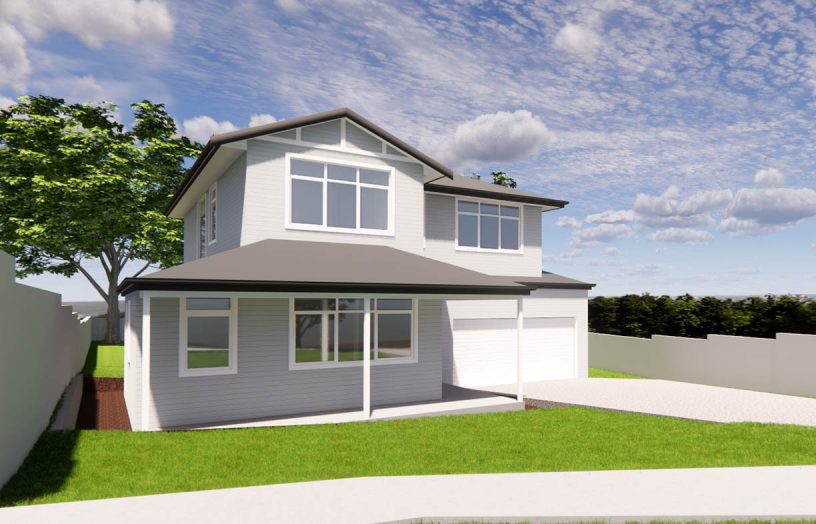
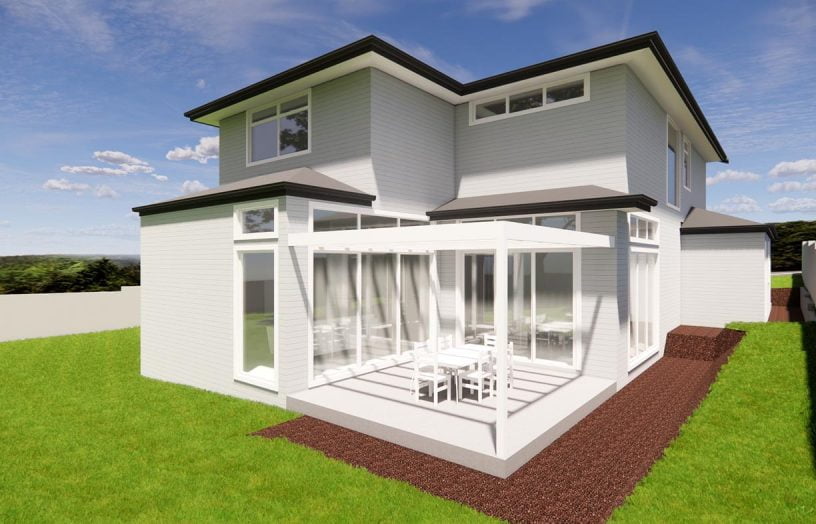
Erika and Penny’s response
First, we’d like to offer some initial impressions of your proposed design.
It’s great that the main living spaces have good orientation to the north and east, providing easy access to sun and daylight, and good visual and physical connection to outdoor spaces.
The decision to remove the roof over the alfresco area and replace it with a pergola for seasonal shading is a smart one. Deciduous vines are a cost-effective and beautiful way of providing shade in summer, while allowing the winter sun through. In addition to shading both the windows and walls, you will get the benefit of transpiration cooling. Vines of any type will require some maintenance to encourage them to grow where you want and will require pruning to keep them looking good. You may also want to consider interim shading such as inexpensive off-the-shelf blinds until the vines have established.
We also applaud the double glazing and upgrade of insulation: it’s important to make the building envelope as thermally efficient as possible. The house energy rating will reveal how well this works overall. You may find that some further improvements are needed to meet the required 6-Star rating, as well as new NCC heating and cooling load limits. R2.5 in walls is common now, and R5 easily fits in most ceilings. Double glazing is also highly recommended to the large sliding doors in the living area, as this space is the most frequently occupied and conditioned area of the house.
A house energy rating is highly recommended before submitting the planning application. Now is the most cost-effective time to make changes, before the design is locked in with Council and the builders – any revisions to the planning permit, building permit and building contract will likely incur additional costs. We see the house energy rating as an important tool in the design process, which can help quantify the benefits of the changes we have recommended below.
Key challenges
A number of the windows don’t have adequate shading in summer. This poses a real risk to occupant comfort in hot weather (especially in west-facing bedrooms), and may also cause problems with energy efficiency compliance, particularly the new NCC cooling load limits.
Some north-facing windows aren’t making the most of beneficial winter sun, tucked up directly under the eaves. The top portion of these windows will rarely receive any sun, even in mid-winter. This arrangement also reduces daylight and obscures the view to the sky.
Large single-glazed doors will act as a big thermal ‘hole’ in the primary living space, reducing comfort and efficiency and compromising the investment in double glazing and insulation elsewhere.
There is limited opportunity for cross ventilation for passive cooling due to the current window layout with its limited number of windows to the south.
There is currently little thermal or acoustic zoning. Without any internal separation, both heat and noise will travel throughout the house including up and down the stairs.
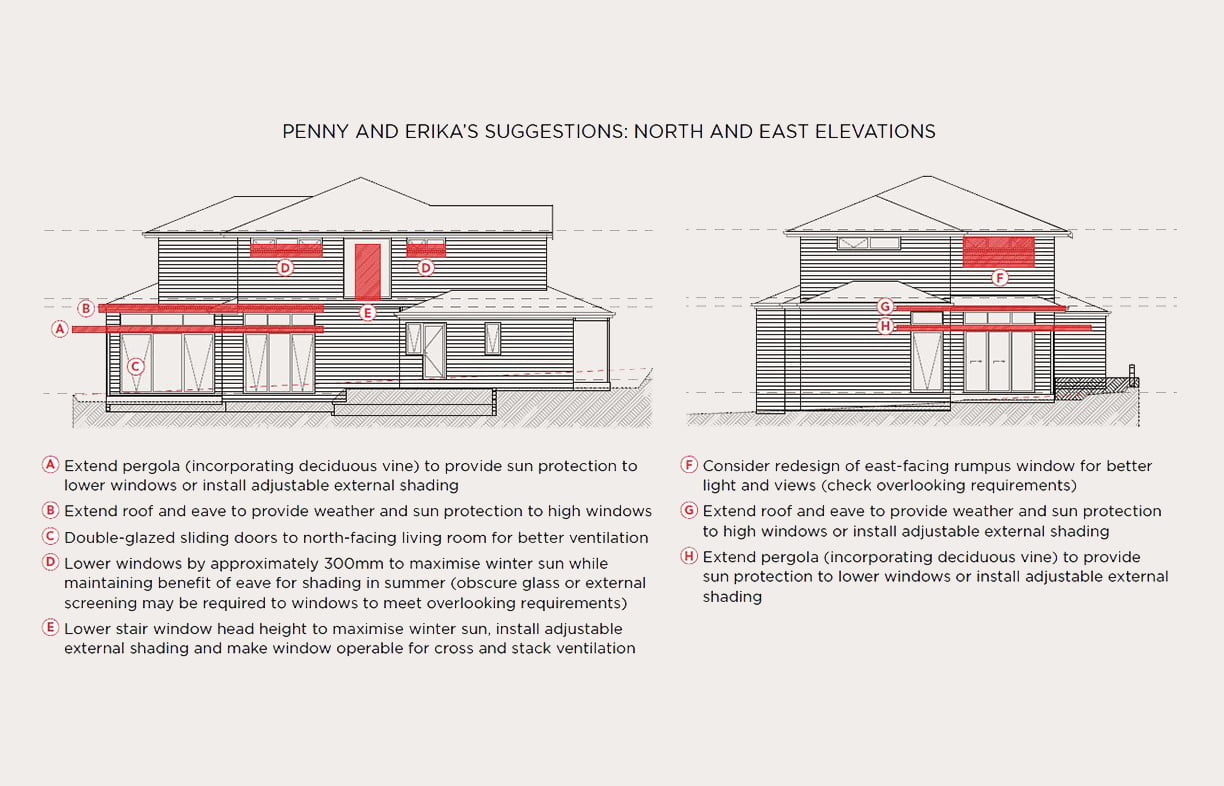
Our recommendations
We’ve made a series of recommendations to improve the comfort and thermal performance of the home, while respecting the overall design and acknowledging the constraints of the project and budget. We’ve split these into three steps: easy wins, priorities for performance and ‘nice to have’.
Easy wins
These are our best ‘bang-for-buck’ changes, and we actually see them as must-do items. They tackle the biggest problem areas with very little change to the overall design.
External adjustable summer shading:
- External blinds should be added to the west-facing bedroom windows as a priority. Although the lower windows have a deep eave this will have limited effectiveness on this orientation, especially on hot summer afternoons. Ground floor blinds could be installed on each window, or at the outer edge of the verandah. First floor blinds will probably need to be motorised. If these aren’t done as part of the building contract they could be installed later; just make sure allowances are made in the build, such as providing power for the first floor blinds.
- We recommend extending the pergola to provide shade for the north-facing dining window and east-facing living room window (if this isn’t possible, then these windows will need external blinds). Once established, the proposed deciduous vines will provide good protection to all of the lower north and east windows. The small eaves should also be extended to shade all of the high-level living space windows to the north and east.
- The large north-facing window in the stairwell needs some shading too, as the eave is too small for the height of this window. We recommend an external blind here too (and make some further suggestions for the size and opening type of this window later on in our recommendations).
Internal zoning:
- To improve thermal and acoustic performance, we highly recommend including a door (or doors) to separate the ground floor living spaces from the entry hallway and stairs. This means heating or cooling in this space is not lost up the stairs, or whenever someone opens the front door. It will also improve acoustic separation across the house.
- Your brief mentions soundproofing upstairs, including somewhere for the kids to watch films and play. The rumpus is currently very acoustically connected to the rest of the house, with the open balustrade to the stairs. (This feature might also contribute to some overlooking from the rumpus out of the stairwell window – ask your designer to confirm this.) You could consider a full-height wall instead of a balustrade, which would give you the option to include a door to fully enclose this space if needed.
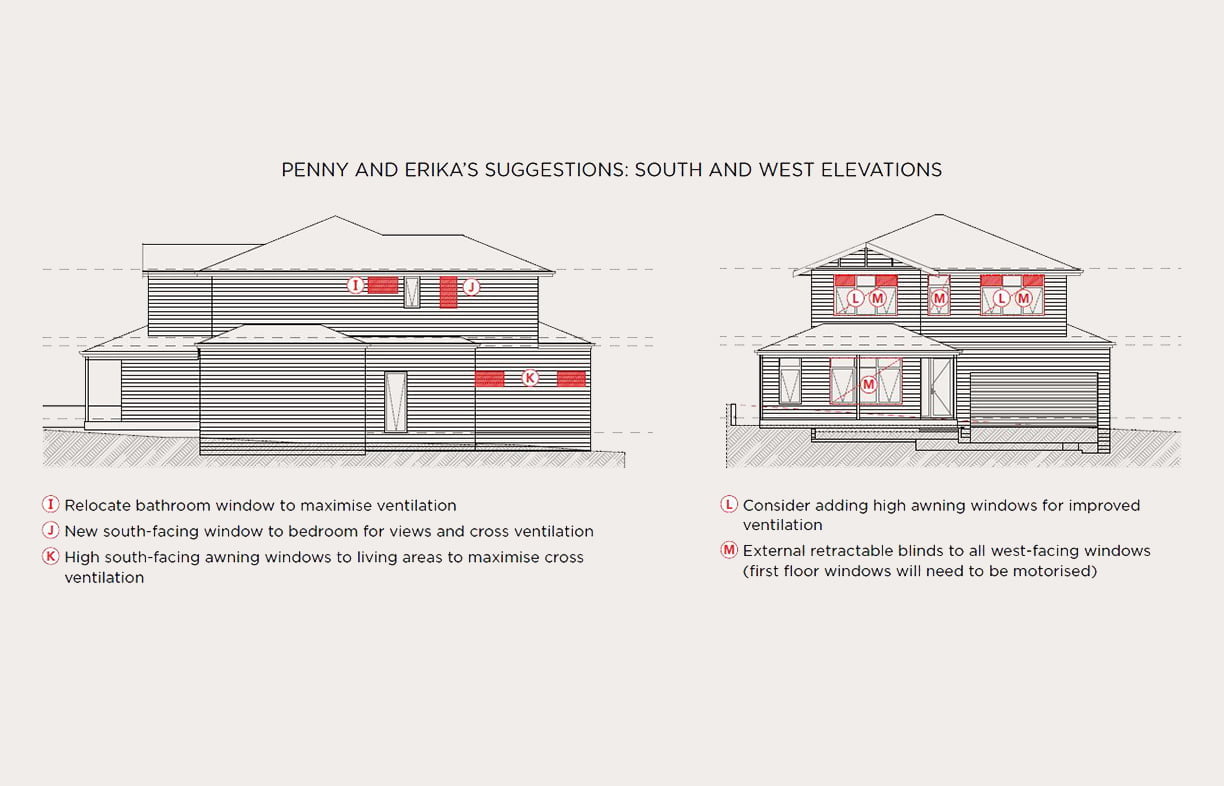
Priorities for performance
These items are focussed on improved comfort and efficiency in the heart of the home, the ground floor living spaces. Given the design investment in these rooms already (the high ceilings, lovely big windows, alfresco pergola and so on), we think it’s worth investing in better performance here too.
Better cross ventilation to the living spaces:
- To improve natural ventilation, as well as better access to the alfresco area, we suggest changing the north-facing living area windows to sliding doors.
- We then recommend adding some small openable windows to the south side of the living area, so cool southerly breezes can provide some passive cooling. Without these openings, little air movement will occur across the majority of the room.
Double-glazed doors:
- To improve thermal performance in the main living space, we highly recommend double glazing the doors as well as windows. As noted above, large single-glazed doors will act as a big thermal ‘hole’ in the room, and compromise the investment you’ve made in double glazing and insulation elsewhere. If you cannot afford double glazing to the whole house, we recommend double-glazing all windows and doors in the primary living spaces as a priority, and upgrading bedrooms next.
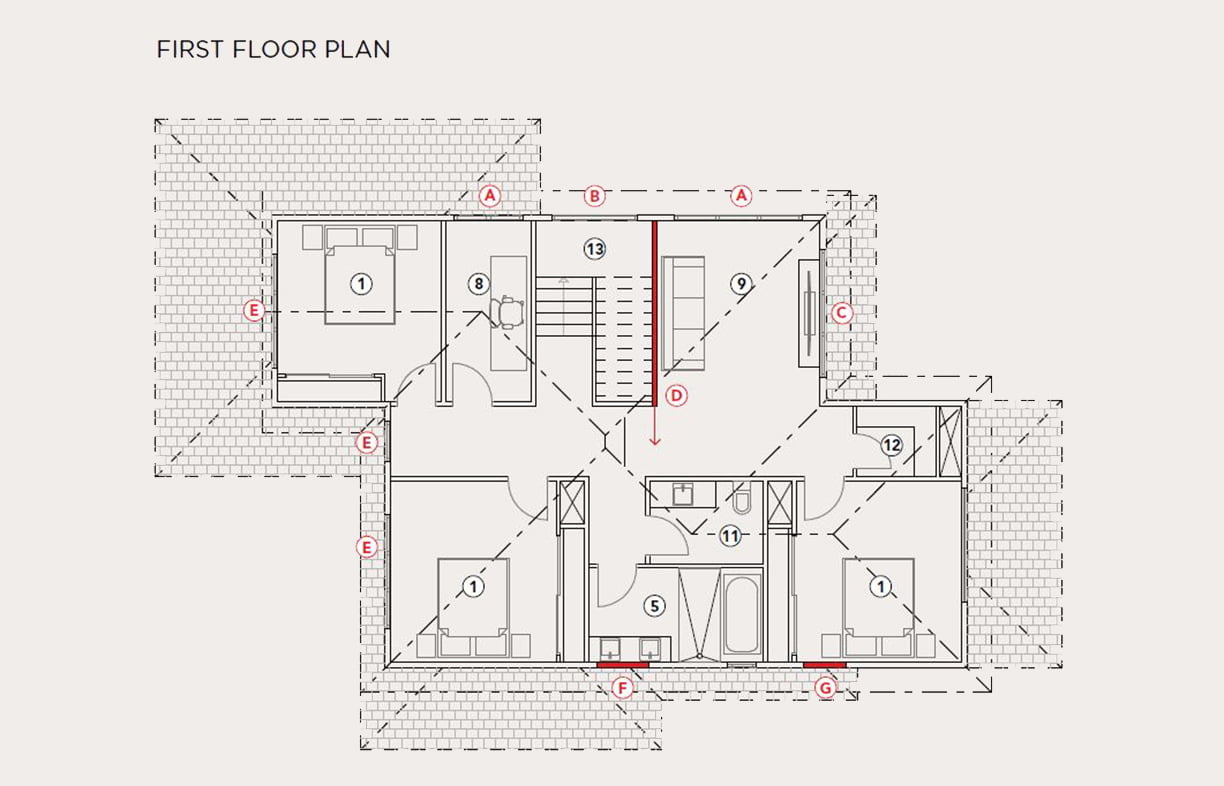
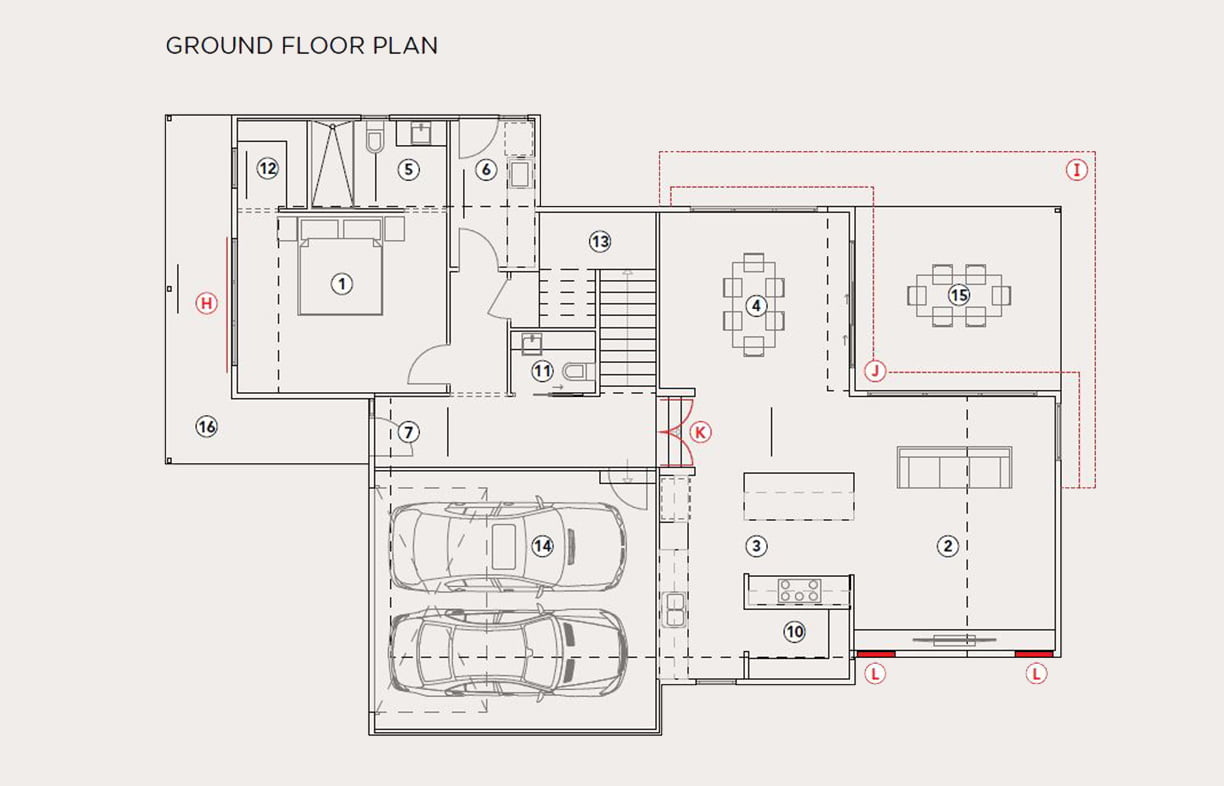
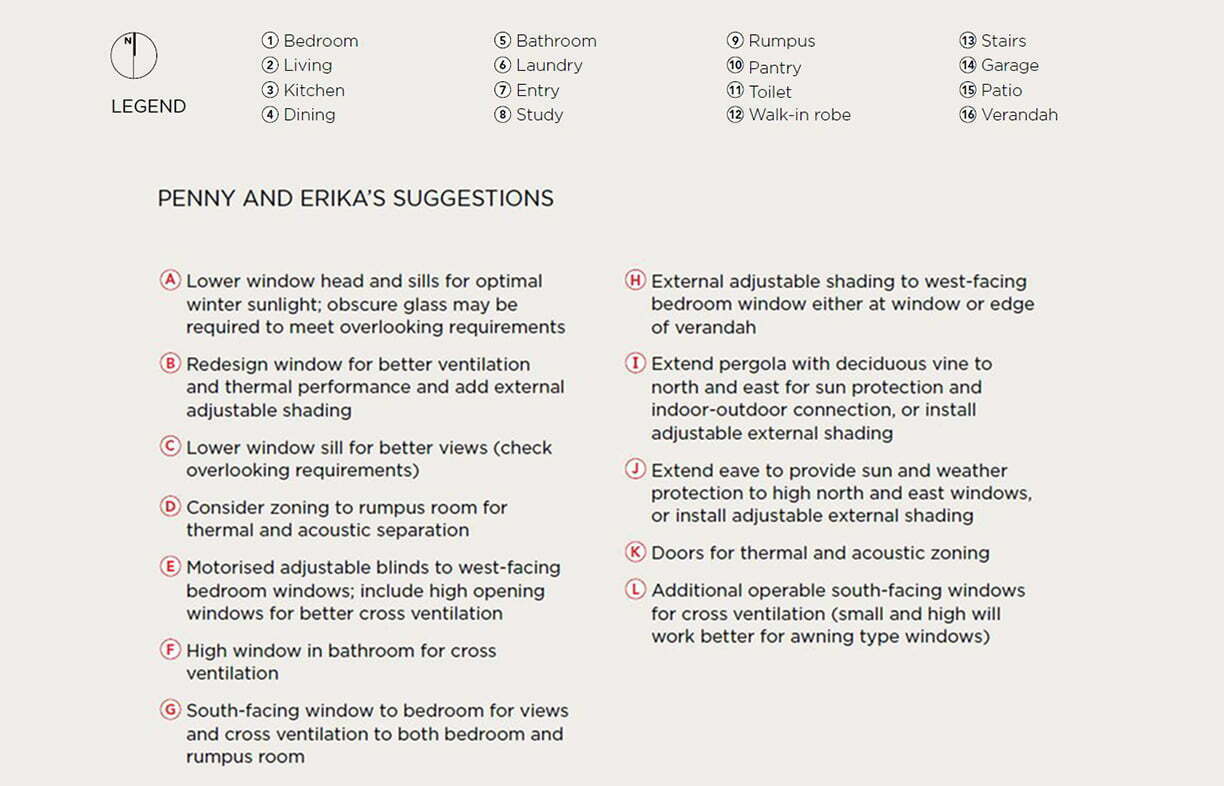
Nice to have
These items require some further design tweaking, but will help to optimise comfort, energy efficiency and amenity across the home. We see them as the ‘icing on the cake’, and if the budget won’t stretch this far, do the other steps first.
Window adjustments:
- We recommend dropping the head heights of the first floor north windows, so they receive more winter sun. If there are overlooking issues for window sills below 1700mm high, these could be moderated with obscure glass or external screens, rather than raising the windows so high.
- We also recommend moderating the size and opening type of the large north-facing stair window. As well as lowering the head height, we recommend shrinking this window to reduce heat loss and gain, while still allowing plenty of sunlight and daylight in. If this window is openable, the stairs could also act as a thermal chimney in summer, allowing heat from the ground floor to flush out of the building. Louvres are very effective (and double-glazed ones are coming onto the market), otherwise one or two high-level awnings would work well.
- To improve opportunities for cross ventilation across the first floor spaces, we recommend adding a window to the south wall of Bedroom 4, and adding (or relocating) a bathroom window above the basins, aligning better with the door. Consider also making some of the upper panes of the west-facing bedroom windows openable, as having both high- and low-level openable windows improves the ventilation in a room where there are windows on only one wall.
- Finally, we think there is opportunity to enlarge the east-facing rumpus window. Based on our estimate, the rumpus window looks unlikely to breach the 9-metre overlooking radius into the neighbouring property, so a lower sill could be accommodated here. This would allow better sunlight, daylight and views into this room, and summer heat could be moderated by an external blind if desired.
Other notes and things to consider
Our general rule of thumb for shading in Melbourne is horizontal shading (like eaves and pergolas) to north windows, and vertical shading (like blinds) to the west and east, because the sun is much lower in the morning and afternoon.
North eaves need to allow enough winter sun, while preventing summer overheating. Fixed eaves can’t be right all year round, as the sun is the same angle in say March and September (swing seasons), but the outside temperature can be very different. We typically use a vertical angle of 60 degrees, measured from the sill of the window, to provide a good depth eave across the seasons.
External shading is best for keeping unwanted sun out in summer. Well-fitting internal blinds are best for keeping the heat in during winter and cool nights (although they also help insulate windows on hot days, if you don’t need them open).
Generally, double glazing is recommended throughout. However, thoughtfully positioned louvres (even if single-glazed) can be incredibly effective at ventilating your house, and might be appropriate in select places, such as the small south-facing windows for cross ventilation and in the stairwell. The house energy rating can help to fine tune this.
Don’t forget about airtightness and draught sealing for thermal efficiency. Ensure you choose good quality, well-sealing doors and windows. The NCC requires you to include back-draught stoppers to all exhaust fans. We recommend using IC-rated downlights to reduce the ‘holes’ in your ceiling insulation – or avoid ceiling penetrations entirely, with surface-mounted lights.
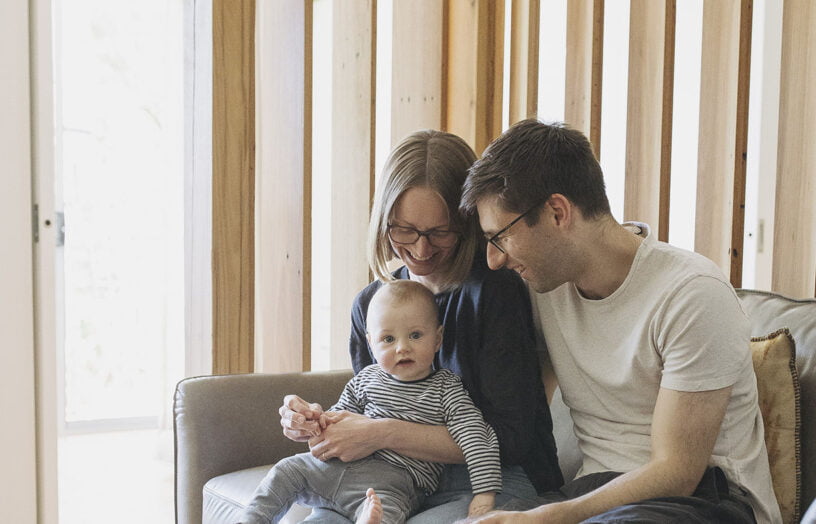 Design workshop
Design workshop
Design workshop revisited: Small space success
With some small but important changes to the internal layout based on our expert’s advice, this expanding young Canberra family is getting more out of their diminutive apartment.
Read more Design workshop
Design workshop
Design workshop: Making a small space work harder
Young professional couple Jess and David love their diminutive Canberra apartment and the productive courtyard garden they have established, and would like to make changes to maximise natural light, make the most of the available space, and accommodate a future family. Small space expert Kate Shepherd of Rob Henry Architects is on hand to help.
Read more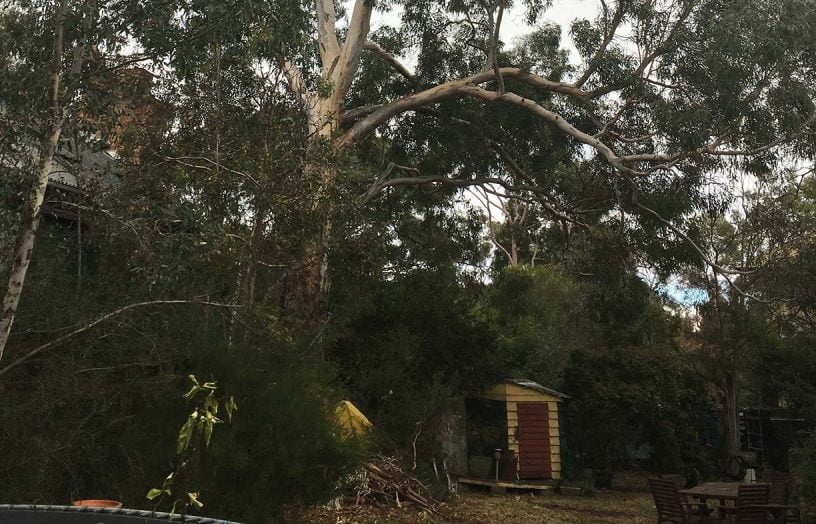 Ideas & Advice
Ideas & Advice
Design Workshop: Down by the river
Having lived in their beloved riverside suburb of Melbourne for ten years, Rowan Doyle and Fiona Cock are planning an updated, more flood-resilient home to accommodate changing family needs. They are interested in prefabrication and Passive House; Sven Maxa of Maxa Design is knowledgeable about both, and gives them some pointers.
Read more

